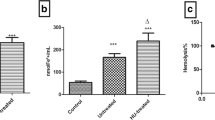Abstract
The role of oxidant damage to red cells in sickle cell anaemia has been of interest in recent years. Although, available reports suggest that sickle cell erythrocytes are susceptible to endogenous free radical mediated oxidant damage there remains discrepancy in the status of antioxidant enzymes and antioxidant vitamins in these patients. In view of this, 107 cases of sickle cell anaemia (36 ‘SS’ and 71 ‘AS’ pattern—as confirmed by haemoglobin electrophoresis) were subjected to analysis of malondialdehyde, ascorbic acid, superoxide dismutase and albumin. The results were compared with 54 age and sex matched healthy controls. The results indicate a marked increase in lipid peroxidation and superoxide dismutase levels in both ‘SS’ and ‘AS’ types of sickle cell anaemia as compared to controls. Although no difference was observed in the levels of albumin in these groups the levels of ascorbic acid were significantly depleted in sickle cell anaemia patients. The results are indicative of enhanced lipid peroxidation along with imbalance in the pro-oxidant and antioxidant status in patients of sickle cell anaemia.
Similar content being viewed by others
References
Ghai, O.P. (1966)Haematological Disorders. Essential Paediatrics. 4th edition. Pages 73–74. Interprint, Mehta Offset works, New Delhi.
Mukherjee, M.B.,et al. (1994) Incidence of sickle cell disease in Nagpur. Indian Journal of Haematology and Blood Transfusion, 12, 219–224.
Essien, E.U. (1994). Increased susceptability of erythrocyte membrane lipids to peroxidation in sickle cell disease. Central African Journal of Medicine 40 (8), 217–220.
Arthur, J.R. and Boyne, R. (1985) Superoxide dismutase and Glutathione peroxidase activities in neutrophils from selenium deficient and copper deficient cattle. Life sciences, 36, 1569–1575.
Kyaw, A. (1978) A simple colorimetric method for ascorbic acid determination in blood plasma. Clinica. Chimica. Acta. 86, 153–157.
Davidson, I. and Henry, J.B. (1969)Todd-Sanford's Clinical diagnosis by laboratory methods. 14th edition, pp. 128–129. W.B. Saunders Company.
Doumas, B.T.,et al. (1972)Standard methods of clinical chemistry. 176–189. Academic Press, Chicago.
Sess, E.D., Carbonneau, M.A., Meite, M., Peuchant, E.,et al. (1998) Markers of lipid peroxidation, inflammatory proteins and plasma tocopherol in homozygotic and heterozygotic sickle cell anaemia. Bull. Soc. Pathol. Exot. 91 (3), 238–241.
Sess, E.D., Carbonneau, M.A., Thomas, M.J., Dunnol, M.F.,et al. (1992) First observations on the main plasma parameters of oxidative stress in homozygous sickle cell disease. Bull. Soc. Pathol. Exot. 85 (2), 174–179.
Preoteasa, E.A. and Ionescu, I. (1995) Fatty acid peroxidation in relation to trace elements in serum of patients with homozygous sickle-cell anaemia and beta-thalassemia: a gas chromatographic study. Nutrition Sep–Oct., 11 (5 Suppl), 546–550.
Hebbel, R.P. (1990) The sickle erythroyte in double jeopardy: autoxidation and iron decompartmentalisation. Seminars in Haematology, 27 (1), 51–69.
Moore, R.B., Brummitt, M.L. and Mankad, V.N. (1989) Hydroperoxides selectivity inhibit human erythrocyte membrane enzymes. Archives of Biochemistry and Biophysics 273 (2), 527–534.
Leclerc, L., Girard, F., Galacteros, F.,et al. (1987). The calmodulin stimulated (Ca2+-Mg2+)—ATPase in hemoglobin S erythrocyte membranes: Effects of sickling and oxidative agents. Biochim. Biophys. Acta. 897, 33–40.
Jain, S.K., Ross, J.D., Levy, G.J.,et al. (1990) The effect of malonyldialdehyde on viscosity of normal and sickle red blood cells. Biochem. Med. Metab. Biol. Aug. 44 (1), 37–41.
Rice-Evans, C., Omorphos, S.C. and Baysal, E. (1986) Sickle cell membranes and oxidative damage. Biochem. J. 237, 265–269.
Das, S.K. and Nair, R.C. (1980) Superoxide dismutase, glutathione peroxidase, catalase, catalase and lipid peroxide of normal and sickled erythrocytes. Br. J. Haematol. 44, 87–92.
Beretta, L., Gerli, G.C., Ferraresi, R.et al. (1983) Antioxidant system in sickle red cells. Acta. haematol. 70, 194–197.
Chiu, D., Vichinsky, E., Ho, S.L.,et al. (1990) Vitamin C deficiency in patients with sickle cell anemia. Am. J. Pediatr. Haematol. Oncol., Fall, 12 (3), 262–267.
Jain, S. and Williams, D.M. (1985) Reduced levels of ascorbic acid (vitamin C) in sickle cell disease patients: Its possible role in the oxidant damage to sickle cellsin vivo. Clin. Chim. Acta. 149, 257–261.
Adelekan, D.A., Thurham, D.I., Adekile, A.D. (1989) Reduced anti-oxidant capacity in paediatric patients with homozygous sickle cell disease. European Journal of Clinical Nutrition 43, 609–614.
Chow, P.T. and Khan, A.U. (1983) L-Ascorbic acid quenching of singlet delta molecular oxygen in aqueous media: generalised antioxidant property of vitamin C. Biochem. Biophys. Res. Commun. 115, 932–937.
Jaja, S.L., Ikotun, A.R., Gbenebitse, S.,et al. (2002) Blood pressure, haematologic and erythrocyte fragility changes in children suffering from sickle cell anemia following ascorbic acid supplementation. J. Trop. Pediatr. Dec. 48 (6). 366–370.
Rana, S.R., Sekhsaria, S. and Castro, O.L. (1993) Haemoglobin S and C traits: Contributing causes for decreased mean haematocrit in African-American children. Paediatrics 91, 800.
Humphries, J.E. and Wheby, M.S. (1992) Case report: Sickle cell trait and recurrent deep vein thrombosis. Am. J. Med. Sci. 303, 112.
Author information
Authors and Affiliations
Rights and permissions
About this article
Cite this article
Titus, J., Chari, S., Gupta, M. et al. Pro-oxidant and anti-oxidant status in patients of sickle cell anaemia. Indian J Clin Biochem 19, 168–172 (2004). https://doi.org/10.1007/BF02894279
Issue Date:
DOI: https://doi.org/10.1007/BF02894279




